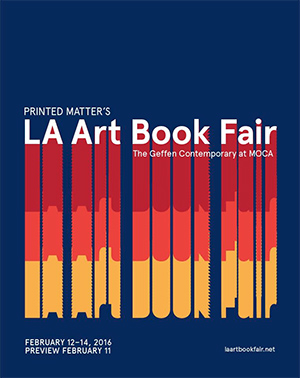| |
|
PRINTED MATTER’S LA ART BOOK FAIR 2016
by Sharon Cheslow
February 2016
 Without much time, I made six stops at Printed Matter’s fourth annual LA Art Book Fair. The event was free to the public, with much support for independent publishers and DIY artists. There was a feeling of community, rather than commodification, keeping in spirit with Printed Matter’s NYC artist’s book roots as founded in 1976 by Sol Lewitt and Lucy Lippard. Without much time, I made six stops at Printed Matter’s fourth annual LA Art Book Fair. The event was free to the public, with much support for independent publishers and DIY artists. There was a feeling of community, rather than commodification, keeping in spirit with Printed Matter’s NYC artist’s book roots as founded in 1976 by Sol Lewitt and Lucy Lippard.
In the Gagosian Gallery booth, with its librarian/archivist Ben Lee Ritchie Handler on site, Kim Gordon and valiant Bull Tongue Review editor/Feeding Tube owner Byron Coley set up a pop-up store and installation. There were Body/Head 12” records, with covers designed by different artists such as Rita Ackermann and Richard Prince. Byron and Chris D were talking when I stopped by, standing next to the LPs, small press books, and poetry chapbooks (including some items by Chris D and other BTR contributors). Seeing Byron reminded me of his 2011 book C'est La Guerre: Early Writings 1978-1983, with introduction by Mike Watt. If you want to read Byron’s seminal, astute, witty forays into music writing for NY Rocker and Take it!, as well as his letters to Angela Jaeger, the paperback with silkscreened cover by Simon Bossé/Mille Putois is available through Benoît Chaput’s Quebec small press L'Oie de Cravan.
Next stop was Allen Ruppersberg’s booth with Kye Potter. Kye co-edited the inspiring 2009 Onestar Press book The Sky Opened Up With Answers, of interviews by him and Julia Dzwonkoski. Kye showed me Ruppersberg’s music and record cover project, El Segundo Record Club, in which Ruppersberg designs covers for old vinyl he finds and transfers to Recordio Discs and CDs. It works as reclamation of music history. Although not intentional, it fit well with the Body/Head record covers.
At Richard Bell’s booth, with Emory Douglas posters on the walls, a woman assisting Bell struck up a conversation. After expressing my love of the Black Panther Party newspaper Blank Panther, she encouraged me to explain the importance of Emory Douglas’ graphic design to a familiar-looking woman, who just happened to walk up to us as we were talking. I have difficulty recognizing faces sometimes, and didn’t realize until much later the woman was Patricia Arquette!
Louisa Riley Smith founded 20th Century Art Archives in the U.K. in 1985, and at her booth I looked at an amazing 1977 Alice Aycock artist’s book. That led into an invigorating discussion about Rachel Whiteread’s 1993 House public sculpture, Lucy Lippard’s 1973 book Six Years: The Dematerialization of the Art Object from 1966 to 1972 (which I’ve been re-reading), and Washington Project for the Arts (WPA). WPA was founded in Washington, DC in 1975 by artist Alice Denney, and was one of the first places in DC to carry artists’ books.
The next booth was helmed by Jeremy Sanders, whose 6 Decades Books moved recently from NYC to San Francisco. He showed me some late 1970s Liverpool and Manchester punk ephemera (including City Fun zines), and a 1961 Gruppe SPUR journal (affiliated with the Situationists). Best of all was looking at some beautiful hand-painted posters from the May 1968 Paris uprisings. Up close it was possible to imagine the posters hanging on a wall, inciting people to take action.
Adam Davis’ Division Leap from Portland was next. I was interested in their collection from Dick Higgins’ Something Else press. So Adam showed me Daniel Spoerri’s 1966 artist’s book Anecdoted Topography of Chance (a collaboration with Emmett Williams, Robert Filliou, Dieter Roth, Roland Topor), and John Cage’s colorful 1967 Great Bear Pamphlet Diary: How to Improve the World (You Will Only Make Matters Worse). They had a wonderful, obscure 1966 Judson Gallery exhibit catalog for the Stone show by Yoko Ono and Tony Cox. It featured “Sound Forms” by Michael Mason, “Eye Bags” by Yoko Ono, and “Film Message” by Jeff Perkins. Perkins had met Yoko Ono and Tony Cox while in Tokyo in the early 1960s, then lived with them in NYC in 1966. They collaborated on Yoko Ono’s Fluxfilm No. 16 “Four” (NYC version of “Bottoms”) and Jeff Perkins’ Fluxfilm No. 22 “Shout."
There was no time to peruse the Xe(rox) & Paper + Scissors zine room or Wendy Yao’s Ooga Booga booth (representing her original store in LA’s Chinatown, and the newer Ooga Booga #2 in the 356 S. Mission space). No time for hundreds of other exhibitors. However, one thing became clear. No matter how collectible these objects become, and no matter how beautiful they are to the eye, it is the intangible, priceless symbols, images, and ideas they carry that continue to hold relevance – and yes, JOY. All power to the people.
|